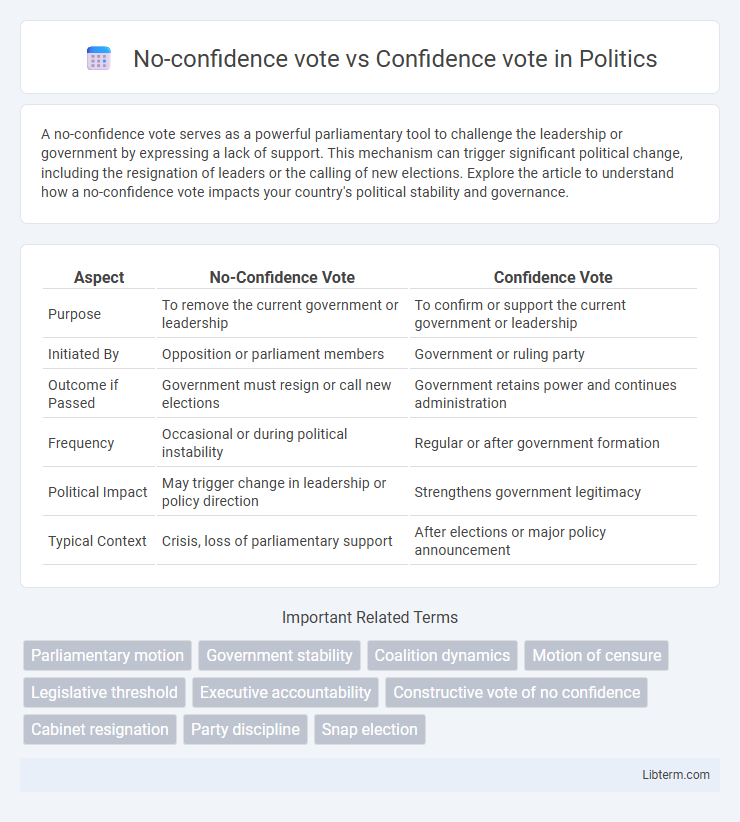A no-confidence vote serves as a powerful parliamentary tool to challenge the leadership or government by expressing a lack of support. This mechanism can trigger significant political change, including the resignation of leaders or the calling of new elections. Explore the article to understand how a no-confidence vote impacts your country's political stability and governance.
Table of Comparison
| Aspect | No-Confidence Vote | Confidence Vote |
|---|---|---|
| Purpose | To remove the current government or leadership | To confirm or support the current government or leadership |
| Initiated By | Opposition or parliament members | Government or ruling party |
| Outcome if Passed | Government must resign or call new elections | Government retains power and continues administration |
| Frequency | Occasional or during political instability | Regular or after government formation |
| Political Impact | May trigger change in leadership or policy direction | Strengthens government legitimacy |
| Typical Context | Crisis, loss of parliamentary support | After elections or major policy announcement |
Understanding No-Confidence and Confidence Votes
A no-confidence vote indicates that a legislative body does not support the current government or leadership, often triggering its resignation or new elections. Conversely, a confidence vote confirms the government's legitimacy and authority to govern, reaffirming parliamentary support. Understanding no-confidence and confidence votes is crucial for analyzing political stability and government accountability in parliamentary systems.
Definition of a No-Confidence Vote
A No-Confidence Vote is a formal parliamentary procedure where members express their lack of support for the incumbent government or leader, aiming to demonstrate that the current administration no longer holds the majority's trust. This vote, often initiated by opposition parties, can lead to the government's resignation or the calling of new elections if it passes. Unlike a Confidence Vote, which seeks to affirm continued support, a No-Confidence Vote challenges the government's legitimacy and stability.
What Constitutes a Confidence Vote
A confidence vote, also known as a vote of confidence, is a parliamentary procedure where the government seeks explicit approval from the legislature to maintain its mandate and continue governing. This vote constitutes a formal test of the ruling party's legitimacy, often triggered after a significant policy decision or political event, requiring a majority support from elected representatives. Failure to secure a confidence vote typically leads to the resignation of the government or dissolution of the legislative assembly, prompting new elections.
Key Differences Between No-Confidence and Confidence Votes
No-confidence votes seek to dismiss an existing government or leader by signaling a loss of parliamentary support, often resulting in resignation or new elections if successful. Confidence votes affirm the government's legitimacy and ensure it retains sufficient legislative backing to govern effectively. The key difference lies in their outcomes: no-confidence votes challenge authority, while confidence votes validate it.
Historical Examples of No-Confidence Votes
No-confidence votes have historically functioned as critical parliamentary tools to challenge or remove sitting governments, with notable examples including the 1979 vote that ousted the UK Labour government under James Callaghan. In contrast, confidence votes, such as the 1993 vote in the Canadian House of Commons, serve to affirm the government's mandate and stability. These votes underline parliamentary democracy's mechanisms for accountability and governance change.
Political Outcomes of Confidence Votes
Confidence votes directly determine a government's legitimacy and ability to govern, with successful votes solidifying political stability and authority. No-confidence votes trigger potential government collapse, prompting early elections or leadership changes that can reshape political dynamics. These parliamentary mechanisms critically influence policy continuity and institutional trust within democratic systems.
Procedures for Initiating Each Type of Vote
No-confidence votes are typically initiated when opposition parties or a significant number of legislators formally submit a motion expressing lack of support for the current government, often requiring a specified number of signatures to proceed. Confidence votes, on the other hand, are generally requested by the incumbent government to demonstrate or reaffirm majority support, often initiated through a formal motion filed by the head of government or cabinet. Both procedures usually involve strict timeframes and parliamentary protocols, such as debate periods and majority thresholds, that govern the scheduling and conduct of the vote.
Impact on Governments and Leadership
A no-confidence vote directly challenges the legitimacy of a government, often leading to its collapse or the resignation of key leaders, thereby triggering elections or coalition reformation. A confidence vote reinforces the government's authority, affirming the leadership's mandate and stability in policy implementation. These parliamentary mechanisms crucially influence political continuity and the ability to govern effectively.
Legal Framework and Requirements
A no-confidence vote requires a majority of legislators to express disapproval of the government, often leading to its resignation or dissolution, as stipulated by constitutional or parliamentary rules. Confidence votes demand a government to demonstrate majority support to maintain authority, with procedures defined by legal frameworks such as parliamentary standing orders or national constitutions. Both votes serve as essential mechanisms in democratic systems, ensuring government accountability and adherence to legislative mandates.
Implications for Political Stability
No-confidence votes signal parliamentary disapproval of the current government, often leading to cabinet resignations or new elections, thereby introducing political uncertainty and potential instability. Confidence votes, conversely, reaffirm the government's legitimacy, reinforcing political stability and enabling policy continuity. Governments surviving confidence votes typically gain strengthened authority to implement their agendas, which can enhance investor confidence and public trust.
No-confidence vote Infographic

 libterm.com
libterm.com